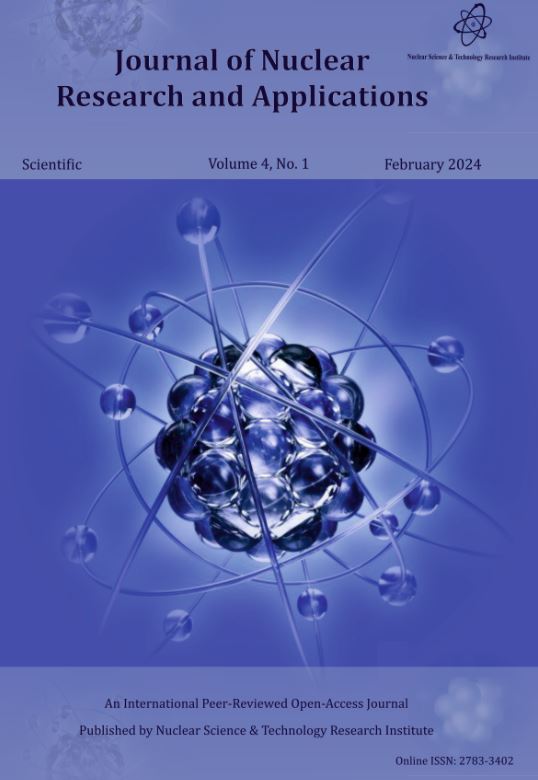Document Type : Technical Paper
Authors
- H. Aghayan 1
- H. Yousefnia 2
- A. Maleki Farsan 3
- A. M. Taherian 3
- Kh. Khoushnodi 1
- T. Yousefi 1
- H. Najafian 1
- Z. Shiri-Yekta 1
1 Nuclear Fuel Cycle Research School, Nuclear Science and Technology Research Institute, P.O. Box: 11365-8486, Tehran, Iran
2 Radiation Application Research School, Nuclear Science and Technology Research Institute, AEOI, P. O. Box 11365-3486, Tehran, Iran
3 Iran Radioactive Waste Management Company, Postcode: 1439955391, Tehran, Iran.
Abstract
One of the key influencing parameters in the safe management of nuclear waste repositories is the distribution coefficient ( ) of radionuclides on bedrock. In this study, of uranium and thorium ions in intact bedrock were determined using batch experiments on crushed bedrock at seven different particle size fractions as well as three different initial concentrations of ions. Sorption experiments have been performed on crushed bedrock prepared from intact drill core samples and an aqueous solution containing desired ions from the local water (LW) near Anarak Nuclear Waste Repository. The results showed that both factors of the initial ions concentration as well as the size of the crushed bedrock particles significantly affect the value of the distribution coefficient so that ( value increases with decreasing particle size and increasing ion concentration. Also, ( calculated at three studied concentrations showed that the difference in the
( values in smaller particles is large but decrease with increasing particle size and ( ) curves for two concentrations of (100 and 10) ppm overlap at the end of the chart. Therefore, it can be concluded that for accurate calculation, it is better to use large particles and low concentrations of ions to determine ( ) in intact bedrock. In this report, different mechanisms including chemical interactions, physical adsorption, and ion exchange were presented for ion adsorption by bedrock. The proposed mechanisms were related to the type of metal speciation of ions in the solution. Based on the obtained data, the preferred mechanism to describe the adsorption of uranium and thorium ions is composed of chemical interactions and physical adsorption.
Keywords
Main Subjects
- Regulations on radioactive waste management, Iran Nuclear Regulatory Authority, INRA-MA-RE-200-50/01-0-June. 2010, JONRA
- INTERNATIONAL ATOMIC ENERGY AGENCY, Handbook of Parameter Values for the Prediction of Radionuclide Transfer in Temperate Environments, Technical Reports Series No. 364, IAEA, Vienna. 1994.
- INTERNATIONAL ATOMIC ENERGY AGENCY, Sediment Kd and Concentration Factors for Radionuclides in the Marine Environment, Technical Reports Series No. 247, IAEA, Vienna.1985.
- INTERNATIONAL ATOMIC ENERGY AGENCY, Sediment Distribution Coefficients and Concentration Factors for Biota in the Marine Environment, Technical Reports Series No. 422, IAEA, Vienna. 2004.
- INTERNATIONAL ATOMIC ENERGY AGENCY, Handbook of Parameter Values for the Prediction of Radionuclide Transfer in Terrestrial and Freshwater Environments, Technical Reports Series No. 472, IAEA, Vienna. 2010.
- INTERNATIONAL ATOMIC ENERGY AGENCY, Quantification of Radionuclide Transfer in Terrestrial and Freshwater Environments for Radiological Assessments, Technical Document Series No. 1616, IAEA, Vienna. 2009.
- INTERNATIONAL ATOMIC ENERGY AGENCY, the Safety Case and Safety Assessment for the Disposal of Radioactive Waste, Safety Standards Series No. SSG-23, IAEA, Vienna. 2012.
- Steve S, Jeff L, Barb S, Solid/liquid partition coefficients (Kd) for selected soils and sediments at Forsmark and Laxemar-Simpevarp, Swedish Nuclear Fuel and Waste Management Co, R-09-27, 2009.
- UNDERSTANDING VARIATION IN PARTITION COEFFICIENT, Kd, VALUES, Volume II: Review of Geochemistry and Available Kd Values for Cadmium, Cesium, Chromium, Lead, Plutonium, Radon, Strontium, Thorium, Tritium (3H), and Uranium, United States Environmental Protection Agency, Office of Air and Radiation, EPA 402-R-99-004B, 1999.
- UNDERSTANDING VARIATION IN PARTITION COEFFICIENT, Kd, VALUES, Volume III: Review of Geochemistry and Available Kd Values for Americium, Arsenic, Curium, Iodine, Neptunium, Radium, and Technetium, United States Environmental Protection Agency, Office of Air and Radiation, EPA 402-R-04-002C, 2004.
- Nuclear Energy Agancy, NEA Sorption Project Phase III: Thermodynamic Sorption Modelling in Support of Radioactive Waste Disposal Safety Cases, ISBN : 978-92-64-17781-9, 2012.
- PACIFIC NORTHWEST NATIONAL LABORATORY, Hanford Contaminant Distribution Coefficient Database and Users Guide, PNNL-13895 Rev. 1, 2003.
- Taherian AM, Maleki A, Zolghadri S, Yousefnia H, Shiri-Yekta Z, Sarfi S, Aghayan H, Momenzadeh S, Distribution coefficient of Nickel on Alluvium soil of Anarak Nuclear Repository in and Iran, Journal of Nuclear Research & Applications, 2022; 2; 34-41.
- Taherian AM, Maleki A, Zolghadri S, Yousefnia H, Z Shiri-Yekta Z, Sarfi S, Aghayan H, Momenzadeh S, Distribution coefficient determination of thorium on alluvium soil of Anarak Nuclear Repository, Journal of Nuclear Science and Technology; 2022; 99(2).
- Lehto J, Puukko E, Lindberg A, Voutilainen M, Mikko, Electromigration experiments for studying transport parameters and sorption of cesium and strontium on intact crystalline rock, Journal of Contaminant Hydrology; 2018; 217; 1-7.
- Lehto J, Puukko E, Lindberg A, Voutilainen M. Batch sorption experiments of cesium and strontium on crushed rock and biotite for the estimation of distribution coefficients on intact crystalline rock, Heliyon; 2019; 5(8): 02296.
- Pettijohn FJ, Potter PE, Siever R, Sand and sandstones. Springer‐Verlag; New York, Berlin, Heidelberg, London, Paris, 1987; 553.
- Uddin F. Montmorillonite: an introduction to properties and utilization. Intech Open, London. 2018.
- Naeimi S, Faghihian H. Performance of novel adsorbent prepared by magnetic metal- organic framework (MOF) modified by potassium nickel hexacyanoferrate for removal of Cs+ from aqueous solution. Separation and Purification Technology. 2017; 175: 255–265.
- Takeno N. Atlas of Eh-pH diagrams, Geological survey of Japan open file report, 2005.

